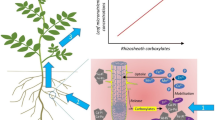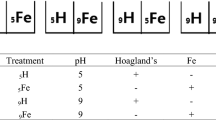Summary
Potted poplars (strainsmarilandica, serotina andFlachslanden ofPopulus euramericana) which developed iron-deficiency symptoms (chlorosis of upper leaves, winter die-back of leader, flushing of lateral buds) were treated with a soil application of iron chelate to study the effect of iron nutrition upon CO2-uptake, iron and pigment content of leaves, and leaf size of a tree species. Foliar content of each iron, chlorophyll, β-carotene, lutein, and violaxanthin was significantly increased by the treatment. Chlorophyll b proved to be particularly sensitive to iron supply and the Qa/b was also significantly altered.
CO2-uptake increased in fertilized and non-fertilized leaves with increasing light up to 40,000 Lux, but fertilized leaves assimilated more CO2 than non-fertilized leaves, especially at light intensities from 5,000 Lux upwards. The assimilatory number was decreased by the iron application since larger amounts of chlorophyll were present in fertilized leaves. If CO2-uptake was based upon an area unit basis the fertilizer effect became distinct even at 500 Lux. Thus CO2-uptake is a quick, valuable measure of fertilizer responses.
In severe cases, iron deficiency also affects leaf size and thus indirectly reduces photosynthetic activity. A chelate application during the growing season will not affect the size of leaves already formed but may considerably increase the size of leaves formed subsequent to the treatment.
Similar content being viewed by others
References
Comar, C. L. and Zscheile, F. P., Analysis of plant extracts for chlorophyll a and b by a photoelectric spectrophotometric method. Plant Physiol.17, 198–209 (1942).
Gasser, R. und Müller, G., Behandlung von Pfanzen zur Bekämpfung der Eisenchlorose.In: Plant Analysis and Fertilizer Problems, pp. 231–245, Inst. Recherches Huiles et Oléagineux, Paris 16e (1956).
Giulimondi, G., Ricerche preliminari sulla nutrizione minerale del pioppo a mezzo dell' analisi foliare. Pubbl. Centro Sper. Agr. Forest. Roma,4, 231–245 (1960).
Heinicke, A. J., Photosynthesis in apple leaves during late fall and its significance in annual bearing. Proc. Am. Soc. Hort. Sci.32, 77–80 (1934).
Keller, Th. und Koch, W., Der Einfluss der Mineralstoffernährung auf CO2-Gaswechsel und Blattpigmentgehalt der Pappel. I. Stickstoff. Mitt. Schweiz. Anst. Forstl. Versuchsw.38, 253–282 (1962).
Keller, Th. und Koch, W., Der Einfluss der Mineralstoffernährung auf CO2-Gaswechsel und Blattpigmentgehalt der Pappel. II. Eisen. Mitt. Schweiz. Anst. Forstl. Versuchw.38, 283–318 (1962).
Koch, W. und Keller, Th., Der Einfluss von Alterung und Abschneiden auf den CO2-Gaswechsel von Pappelblättern. Ber. deut. Botan Ges.74, 64–74 (1961).
Loustalot, A. J., Burrows, F., Gilbert, S. G., and Nason, A., Effect of copper and zinc deficiencies on the photosynthetic activity of the foliage of young tung trees. Plant Physiol.20, 283–288 (1945).
Meyer, B. S. and Anderson, D. B., Plant Physiology, 2. ed. Van Nostrand, New York - London (1952).
Meyer, F. H., Die Entwicklung von Buchenjungpflanzen in unterschiedlichem Bodenmilieu. Ber. deut. Botan Ges.74, 292–299 (1961).
Miller, E. V., Chemistry of Plants. Reinhold Publ. Co., New York (1957).
Olney, V. W., Responses to combination chelate metal sprays including an interaction with certain virus diseases.In: Symposium on the use of metal chelates in plant nutrition. pp. 42–44. Natl. Press, Palo Alto, Calif. (1956).
Reuther, W. and Burrows, F. W., Effect of manganese sulfate on the photosynthetic activity of frenched tung foliage. Proc. Am. Soc. Hort. Sci.40, 73–76 (1942).
Sandell, E. B., Colorimetric Determination of Traces of Metals. 2nd ed. Interscience Publ. Inc., New York (1950).
Schulze, W., Ueber den Einfluss der Düngung auf die Bildung der Chloroplastenpigmente. Z. Pflanzenernähr. Düng., Bodenk.76 (121), 1–19 (1957).
Wallace, T., The Diagnosis of Mineral Deficiencies in Plants. H. M. S. O. London (1951).
Watson, D. J., Comparative physiological studies on the growth of field crops. II. The effect of varying nutrient supply on net assimilation rate and leaf area. Ann. Botany N. S.11, 375–407 (1947).
Author information
Authors and Affiliations
Rights and permissions
About this article
Cite this article
Keller, T., Koch, W. The effect of iron chelate fertilization of poplar upon CO2-uptake, leaf size, and content of leaf pigments and iron. Plant Soil 20, 116–126 (1964). https://doi.org/10.1007/BF01378103
Received:
Issue Date:
DOI: https://doi.org/10.1007/BF01378103




